Risk and Procurement Management in Supply Chain - Edible Solutions
VerifiedAdded on 2020/03/16
|18
|4992
|77
Report
AI Summary
This report provides a comprehensive analysis of risk and procurement management within the supply chain, using Edible Solutions Ltd. as a case study. It explores various types of risks, including those related to product quality, natural disasters, and economic fluctuations, emphasizing the importance of effective risk mitigation strategies in the food industry. The report discusses the role of procurement management, including sustainable procurement processes and the application of theories like agency theory and resource dependency theory. It highlights the significance of supplier relationships, the development of alternative sourcing strategies, and the use of risk registers for identifying and managing risks. The report also examines the impact of external factors like economic changes and the importance of adapting to maintain a secure supply chain. The conclusion underscores the critical need for proactive risk management to ensure the stability and efficiency of food supply chains.
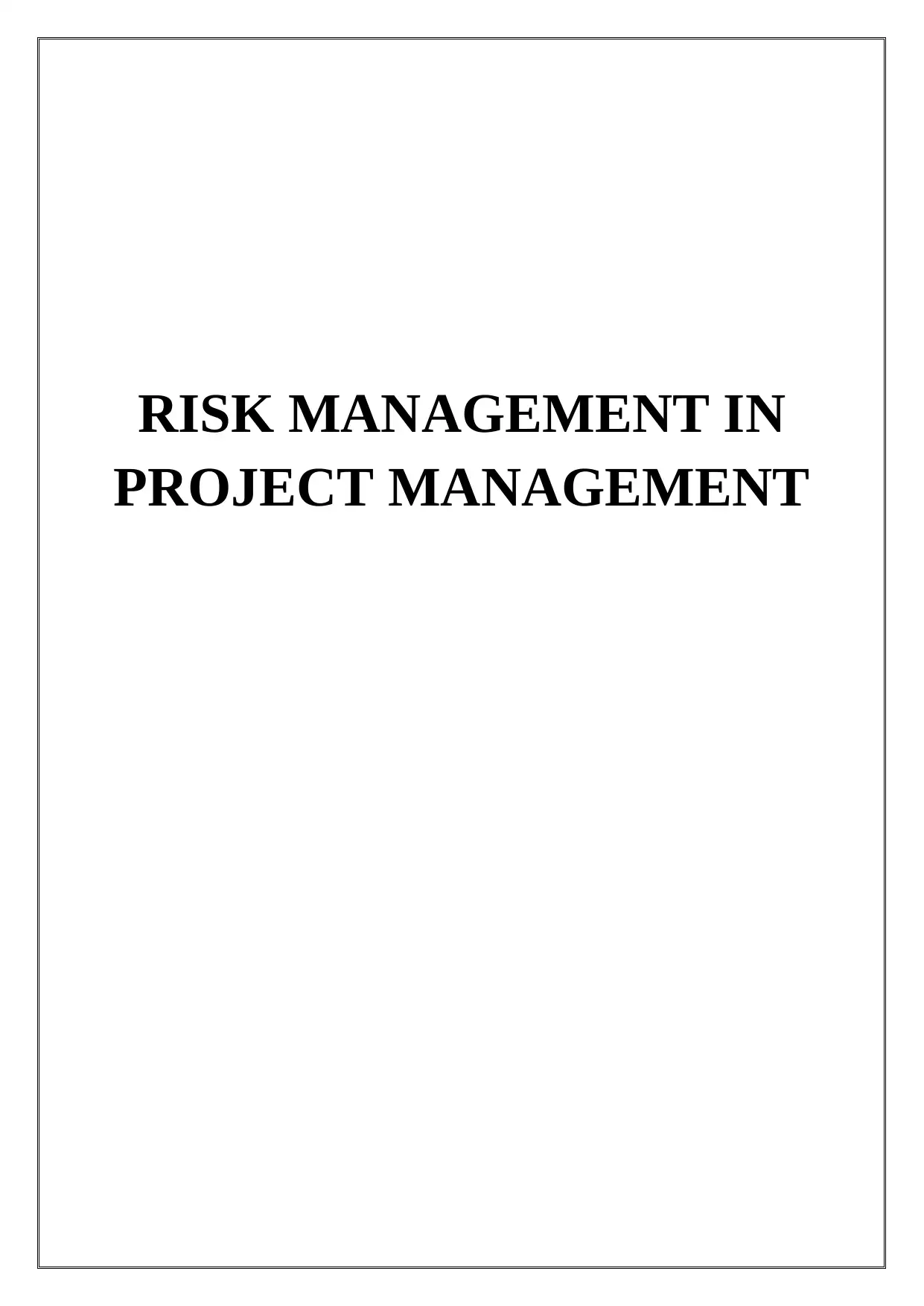
RISK MANAGEMENT IN
PROJECT MANAGEMENT
PROJECT MANAGEMENT
Paraphrase This Document
Need a fresh take? Get an instant paraphrase of this document with our AI Paraphraser
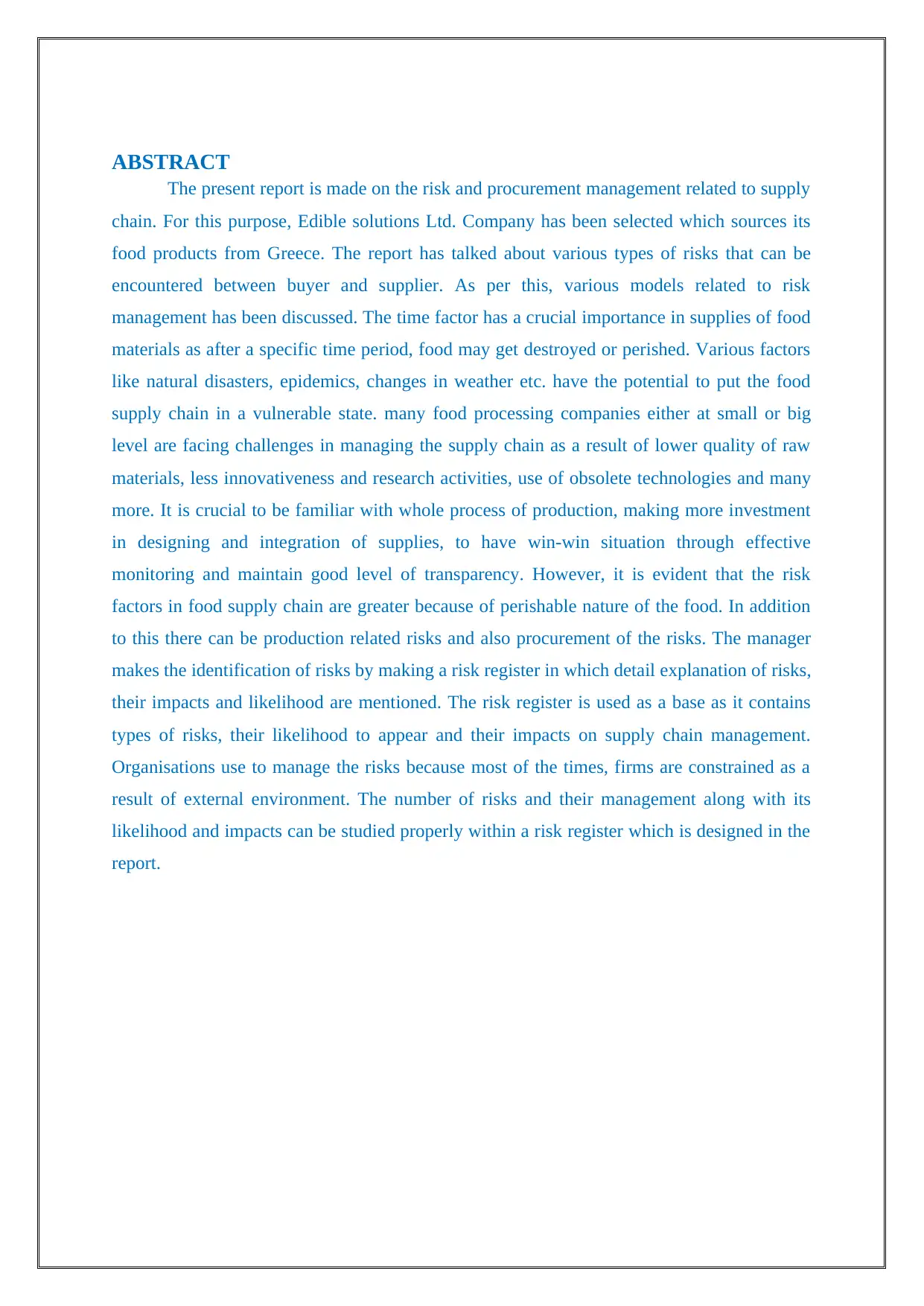
ABSTRACT
The present report is made on the risk and procurement management related to supply
chain. For this purpose, Edible solutions Ltd. Company has been selected which sources its
food products from Greece. The report has talked about various types of risks that can be
encountered between buyer and supplier. As per this, various models related to risk
management has been discussed. The time factor has a crucial importance in supplies of food
materials as after a specific time period, food may get destroyed or perished. Various factors
like natural disasters, epidemics, changes in weather etc. have the potential to put the food
supply chain in a vulnerable state. many food processing companies either at small or big
level are facing challenges in managing the supply chain as a result of lower quality of raw
materials, less innovativeness and research activities, use of obsolete technologies and many
more. It is crucial to be familiar with whole process of production, making more investment
in designing and integration of supplies, to have win-win situation through effective
monitoring and maintain good level of transparency. However, it is evident that the risk
factors in food supply chain are greater because of perishable nature of the food. In addition
to this there can be production related risks and also procurement of the risks. The manager
makes the identification of risks by making a risk register in which detail explanation of risks,
their impacts and likelihood are mentioned. The risk register is used as a base as it contains
types of risks, their likelihood to appear and their impacts on supply chain management.
Organisations use to manage the risks because most of the times, firms are constrained as a
result of external environment. The number of risks and their management along with its
likelihood and impacts can be studied properly within a risk register which is designed in the
report.
The present report is made on the risk and procurement management related to supply
chain. For this purpose, Edible solutions Ltd. Company has been selected which sources its
food products from Greece. The report has talked about various types of risks that can be
encountered between buyer and supplier. As per this, various models related to risk
management has been discussed. The time factor has a crucial importance in supplies of food
materials as after a specific time period, food may get destroyed or perished. Various factors
like natural disasters, epidemics, changes in weather etc. have the potential to put the food
supply chain in a vulnerable state. many food processing companies either at small or big
level are facing challenges in managing the supply chain as a result of lower quality of raw
materials, less innovativeness and research activities, use of obsolete technologies and many
more. It is crucial to be familiar with whole process of production, making more investment
in designing and integration of supplies, to have win-win situation through effective
monitoring and maintain good level of transparency. However, it is evident that the risk
factors in food supply chain are greater because of perishable nature of the food. In addition
to this there can be production related risks and also procurement of the risks. The manager
makes the identification of risks by making a risk register in which detail explanation of risks,
their impacts and likelihood are mentioned. The risk register is used as a base as it contains
types of risks, their likelihood to appear and their impacts on supply chain management.
Organisations use to manage the risks because most of the times, firms are constrained as a
result of external environment. The number of risks and their management along with its
likelihood and impacts can be studied properly within a risk register which is designed in the
report.

TABLE OF CONTENTS
ABSTRACT...............................................................................................................................2
INTRODUCTION......................................................................................................................5
Product quality risk management...........................................................................................5
Role of procurement management.........................................................................................6
Sustainable procurement process...........................................................................................7
CRITICAL ANALYSIS OF THE RISK MANAGEMENT THEORIES.................................8
Agency theory........................................................................................................................8
Resource dependency theory..................................................................................................8
Resource-based view theory..................................................................................................9
Risk management in supply chain........................................................................................10
CONCLUSION........................................................................................................................15
REFERENCES.........................................................................................................................16
ABSTRACT...............................................................................................................................2
INTRODUCTION......................................................................................................................5
Product quality risk management...........................................................................................5
Role of procurement management.........................................................................................6
Sustainable procurement process...........................................................................................7
CRITICAL ANALYSIS OF THE RISK MANAGEMENT THEORIES.................................8
Agency theory........................................................................................................................8
Resource dependency theory..................................................................................................8
Resource-based view theory..................................................................................................9
Risk management in supply chain........................................................................................10
CONCLUSION........................................................................................................................15
REFERENCES.........................................................................................................................16
⊘ This is a preview!⊘
Do you want full access?
Subscribe today to unlock all pages.

Trusted by 1+ million students worldwide
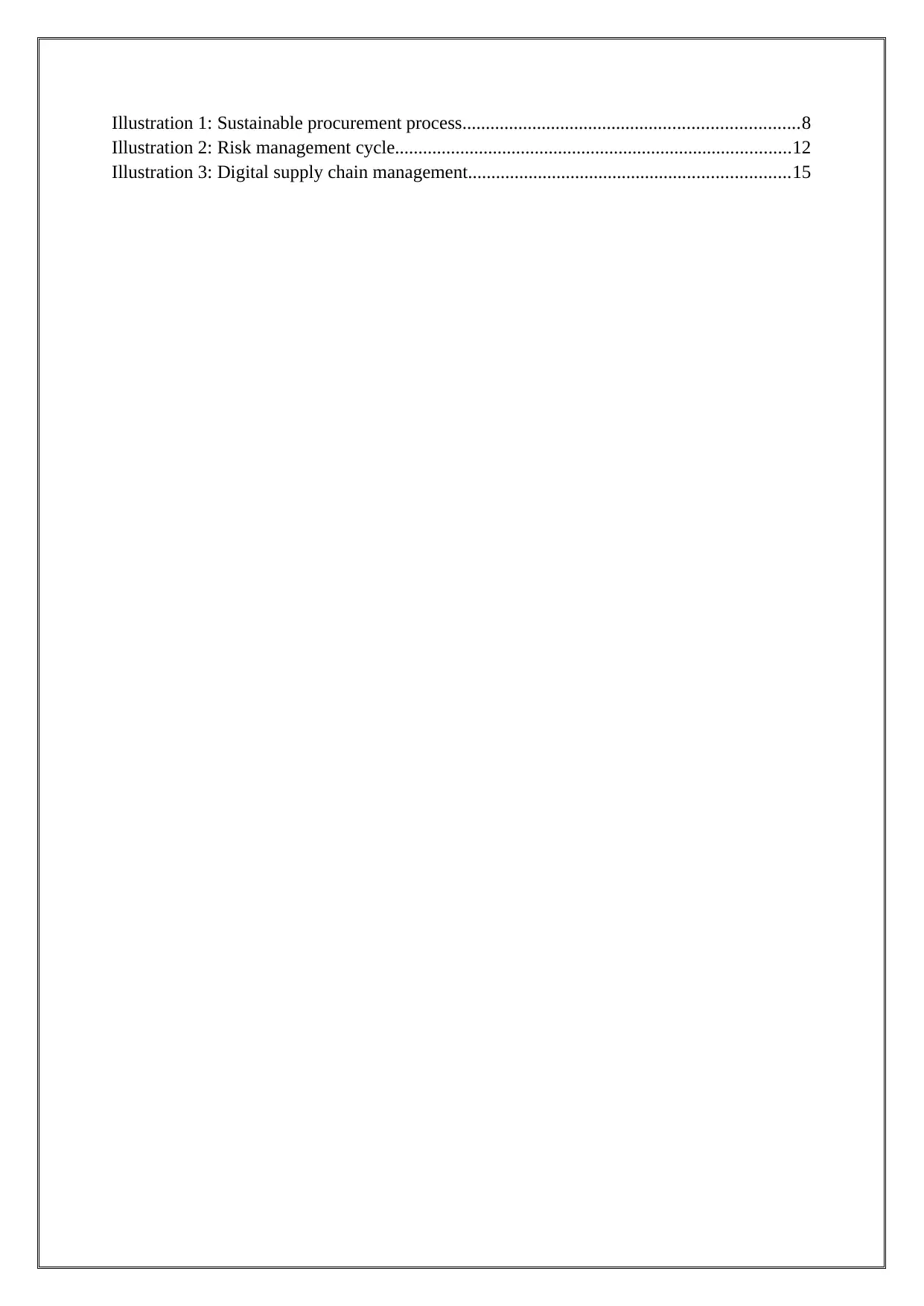
Illustration 1: Sustainable procurement process........................................................................8
Illustration 2: Risk management cycle.....................................................................................12
Illustration 3: Digital supply chain management.....................................................................15
Illustration 2: Risk management cycle.....................................................................................12
Illustration 3: Digital supply chain management.....................................................................15
Paraphrase This Document
Need a fresh take? Get an instant paraphrase of this document with our AI Paraphraser

INTRODUCTION
The risk is a probability of happening something unwanted which can impact the
management and operations of the organisation. The food chain supply management
comprise of greatest risks which is essential to be managed as it can lay a immense challenge
for the company. The other sectors of economy sustain risks through various measures while,
the food chain supply has greater risk because of the perishable nature of food. As per this,
industries related to food supply chain is essential to be managed in most efficient way that
can help in handling of potential risks of its vulnerabilities (Phillips, 2013). The present study
is based on risk and procurement management in which a UK based firm Edible solutions
Ltd. who imports the food products from Greece has been chosen for detailed discussion. The
report will carry out a critical discussion on supplier relationship management and various
risks that can be faced in supply chain.
Product quality risk management
There are a number of risks in the supply chain management which can exist either
internally or externally. The impact of this supply chain risk is high which has the potential to
affect the operations of business seriously. According to Fu, Lee and Teo, (2010), the risk in
food supply chain is higher as compared to other business organisations engaged in supply
chains as food is a perishable thing. The time factor has a crucial importance in supplies of
food materials as after a specific time period, food may get destroyed or perished. Various
factors like natural disasters, epidemics, changes in weather etc. have the potential to put the
food supply chain in a vulnerable state. As per these complexities related to food supply
chain, it is crucial to integrate various functions in best possible way so as to minimise the
risks related to supply chain of food and maintain the quality of products. From the reports, it
has been found that the demands related to various food has increased to very high level in
UK as compared to supplies. Besides this, various recent scandals related to quality oif food
products have raised awareness among public. Thus, there is an increasing demand of
regulation for food safety so as to supply quality products (Sodhi, Son and Tang, 2012). As
per the scenario, the Edible solutions Ltd. of UK import the food materials from Greece. The
organisation makes attempt to provide high quality products that has been imported buy
reliable suppliers so that further processing can be done in right manner and end product
reaches with same quality. Therefore, the organisation uses to apply various technologies and
The risk is a probability of happening something unwanted which can impact the
management and operations of the organisation. The food chain supply management
comprise of greatest risks which is essential to be managed as it can lay a immense challenge
for the company. The other sectors of economy sustain risks through various measures while,
the food chain supply has greater risk because of the perishable nature of food. As per this,
industries related to food supply chain is essential to be managed in most efficient way that
can help in handling of potential risks of its vulnerabilities (Phillips, 2013). The present study
is based on risk and procurement management in which a UK based firm Edible solutions
Ltd. who imports the food products from Greece has been chosen for detailed discussion. The
report will carry out a critical discussion on supplier relationship management and various
risks that can be faced in supply chain.
Product quality risk management
There are a number of risks in the supply chain management which can exist either
internally or externally. The impact of this supply chain risk is high which has the potential to
affect the operations of business seriously. According to Fu, Lee and Teo, (2010), the risk in
food supply chain is higher as compared to other business organisations engaged in supply
chains as food is a perishable thing. The time factor has a crucial importance in supplies of
food materials as after a specific time period, food may get destroyed or perished. Various
factors like natural disasters, epidemics, changes in weather etc. have the potential to put the
food supply chain in a vulnerable state. As per these complexities related to food supply
chain, it is crucial to integrate various functions in best possible way so as to minimise the
risks related to supply chain of food and maintain the quality of products. From the reports, it
has been found that the demands related to various food has increased to very high level in
UK as compared to supplies. Besides this, various recent scandals related to quality oif food
products have raised awareness among public. Thus, there is an increasing demand of
regulation for food safety so as to supply quality products (Sodhi, Son and Tang, 2012). As
per the scenario, the Edible solutions Ltd. of UK import the food materials from Greece. The
organisation makes attempt to provide high quality products that has been imported buy
reliable suppliers so that further processing can be done in right manner and end product
reaches with same quality. Therefore, the organisation uses to apply various technologies and
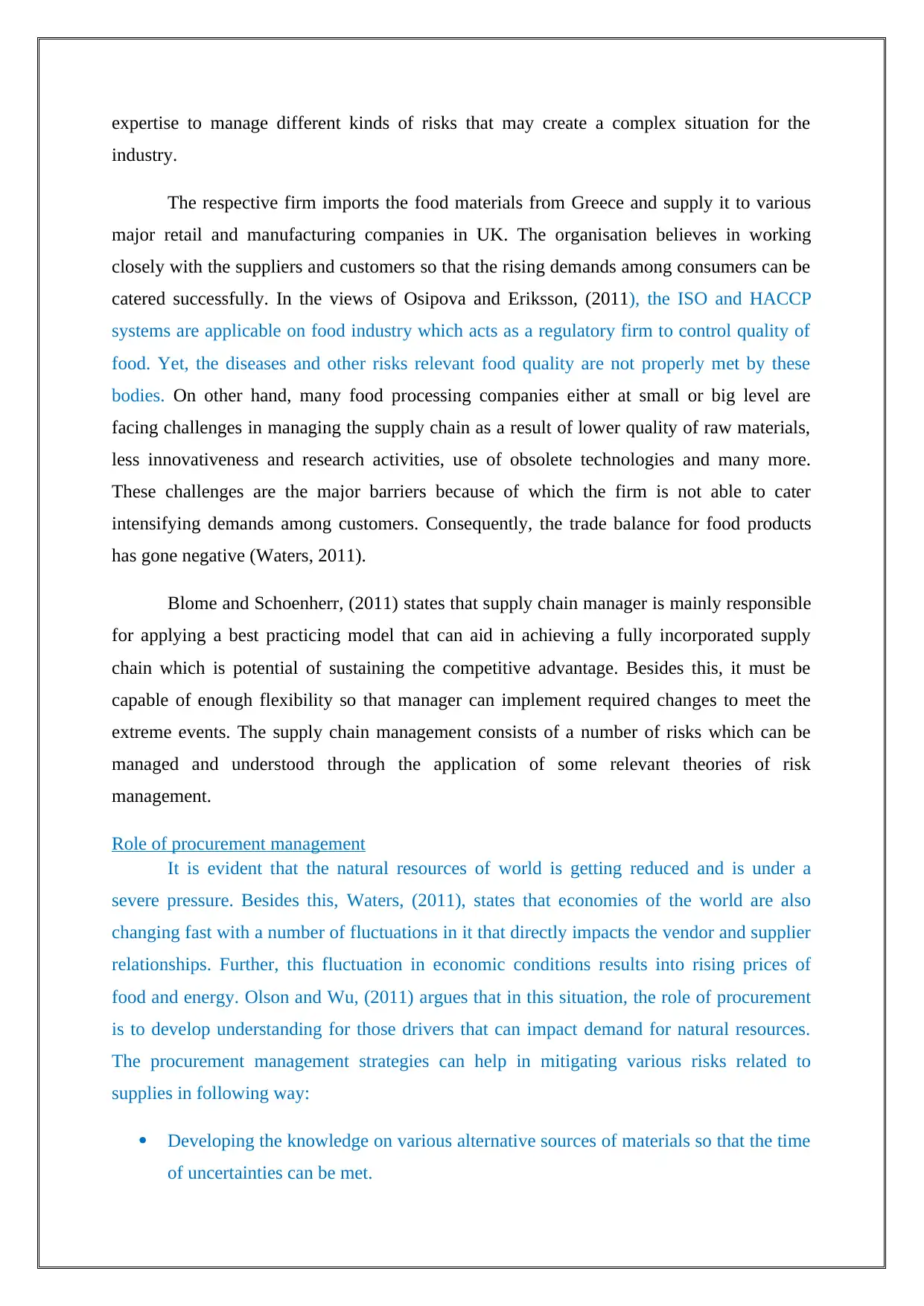
expertise to manage different kinds of risks that may create a complex situation for the
industry.
The respective firm imports the food materials from Greece and supply it to various
major retail and manufacturing companies in UK. The organisation believes in working
closely with the suppliers and customers so that the rising demands among consumers can be
catered successfully. In the views of Osipova and Eriksson, (2011), the ISO and HACCP
systems are applicable on food industry which acts as a regulatory firm to control quality of
food. Yet, the diseases and other risks relevant food quality are not properly met by these
bodies. On other hand, many food processing companies either at small or big level are
facing challenges in managing the supply chain as a result of lower quality of raw materials,
less innovativeness and research activities, use of obsolete technologies and many more.
These challenges are the major barriers because of which the firm is not able to cater
intensifying demands among customers. Consequently, the trade balance for food products
has gone negative (Waters, 2011).
Blome and Schoenherr, (2011) states that supply chain manager is mainly responsible
for applying a best practicing model that can aid in achieving a fully incorporated supply
chain which is potential of sustaining the competitive advantage. Besides this, it must be
capable of enough flexibility so that manager can implement required changes to meet the
extreme events. The supply chain management consists of a number of risks which can be
managed and understood through the application of some relevant theories of risk
management.
Role of procurement management
It is evident that the natural resources of world is getting reduced and is under a
severe pressure. Besides this, Waters, (2011), states that economies of the world are also
changing fast with a number of fluctuations in it that directly impacts the vendor and supplier
relationships. Further, this fluctuation in economic conditions results into rising prices of
food and energy. Olson and Wu, (2011) argues that in this situation, the role of procurement
is to develop understanding for those drivers that can impact demand for natural resources.
The procurement management strategies can help in mitigating various risks related to
supplies in following way:
Developing the knowledge on various alternative sources of materials so that the time
of uncertainties can be met.
industry.
The respective firm imports the food materials from Greece and supply it to various
major retail and manufacturing companies in UK. The organisation believes in working
closely with the suppliers and customers so that the rising demands among consumers can be
catered successfully. In the views of Osipova and Eriksson, (2011), the ISO and HACCP
systems are applicable on food industry which acts as a regulatory firm to control quality of
food. Yet, the diseases and other risks relevant food quality are not properly met by these
bodies. On other hand, many food processing companies either at small or big level are
facing challenges in managing the supply chain as a result of lower quality of raw materials,
less innovativeness and research activities, use of obsolete technologies and many more.
These challenges are the major barriers because of which the firm is not able to cater
intensifying demands among customers. Consequently, the trade balance for food products
has gone negative (Waters, 2011).
Blome and Schoenherr, (2011) states that supply chain manager is mainly responsible
for applying a best practicing model that can aid in achieving a fully incorporated supply
chain which is potential of sustaining the competitive advantage. Besides this, it must be
capable of enough flexibility so that manager can implement required changes to meet the
extreme events. The supply chain management consists of a number of risks which can be
managed and understood through the application of some relevant theories of risk
management.
Role of procurement management
It is evident that the natural resources of world is getting reduced and is under a
severe pressure. Besides this, Waters, (2011), states that economies of the world are also
changing fast with a number of fluctuations in it that directly impacts the vendor and supplier
relationships. Further, this fluctuation in economic conditions results into rising prices of
food and energy. Olson and Wu, (2011) argues that in this situation, the role of procurement
is to develop understanding for those drivers that can impact demand for natural resources.
The procurement management strategies can help in mitigating various risks related to
supplies in following way:
Developing the knowledge on various alternative sources of materials so that the time
of uncertainties can be met.
⊘ This is a preview!⊘
Do you want full access?
Subscribe today to unlock all pages.

Trusted by 1+ million students worldwide
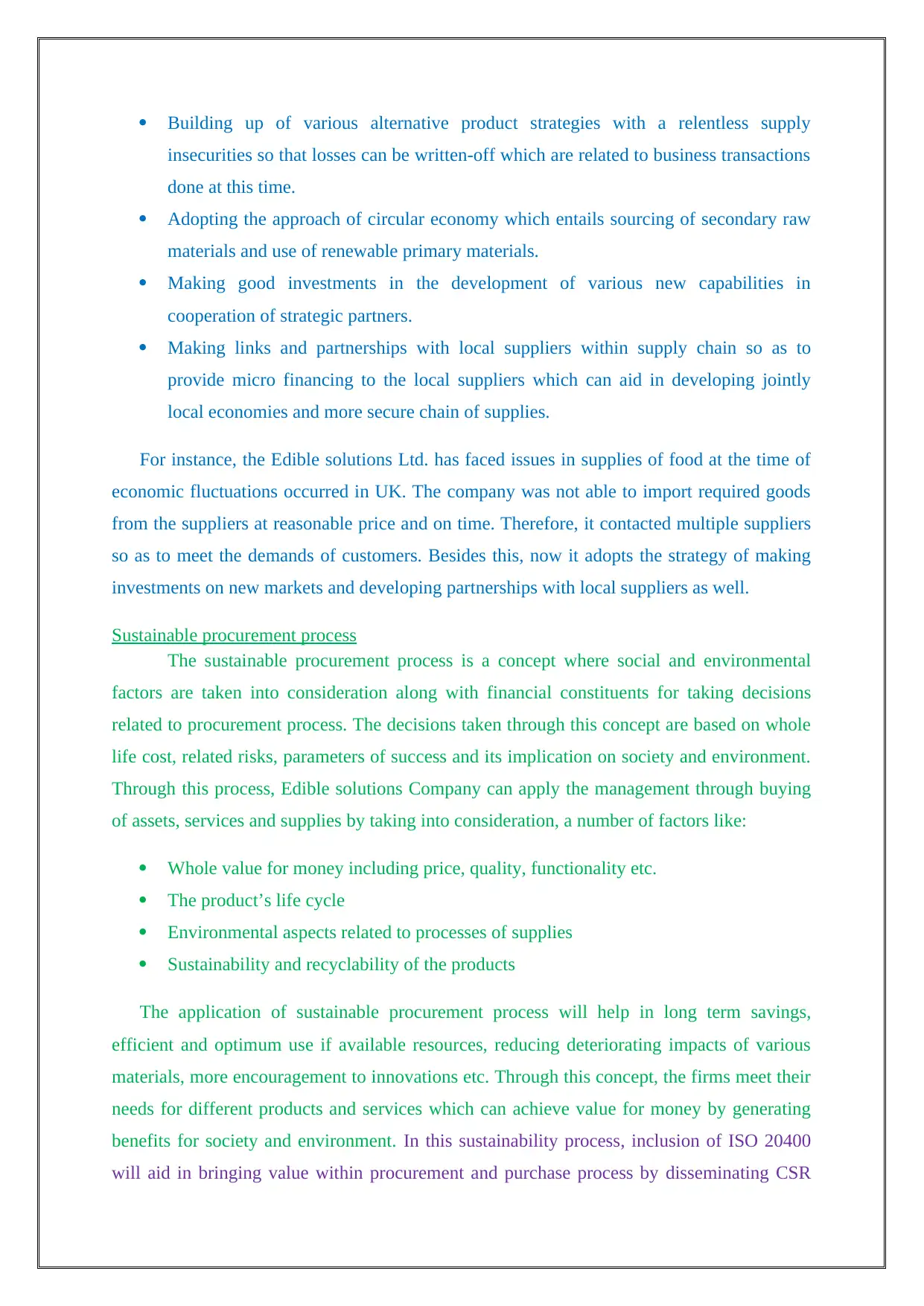
Building up of various alternative product strategies with a relentless supply
insecurities so that losses can be written-off which are related to business transactions
done at this time.
Adopting the approach of circular economy which entails sourcing of secondary raw
materials and use of renewable primary materials.
Making good investments in the development of various new capabilities in
cooperation of strategic partners.
Making links and partnerships with local suppliers within supply chain so as to
provide micro financing to the local suppliers which can aid in developing jointly
local economies and more secure chain of supplies.
For instance, the Edible solutions Ltd. has faced issues in supplies of food at the time of
economic fluctuations occurred in UK. The company was not able to import required goods
from the suppliers at reasonable price and on time. Therefore, it contacted multiple suppliers
so as to meet the demands of customers. Besides this, now it adopts the strategy of making
investments on new markets and developing partnerships with local suppliers as well.
Sustainable procurement process
The sustainable procurement process is a concept where social and environmental
factors are taken into consideration along with financial constituents for taking decisions
related to procurement process. The decisions taken through this concept are based on whole
life cost, related risks, parameters of success and its implication on society and environment.
Through this process, Edible solutions Company can apply the management through buying
of assets, services and supplies by taking into consideration, a number of factors like:
Whole value for money including price, quality, functionality etc.
The product’s life cycle
Environmental aspects related to processes of supplies
Sustainability and recyclability of the products
The application of sustainable procurement process will help in long term savings,
efficient and optimum use if available resources, reducing deteriorating impacts of various
materials, more encouragement to innovations etc. Through this concept, the firms meet their
needs for different products and services which can achieve value for money by generating
benefits for society and environment. In this sustainability process, inclusion of ISO 20400
will aid in bringing value within procurement and purchase process by disseminating CSR
insecurities so that losses can be written-off which are related to business transactions
done at this time.
Adopting the approach of circular economy which entails sourcing of secondary raw
materials and use of renewable primary materials.
Making good investments in the development of various new capabilities in
cooperation of strategic partners.
Making links and partnerships with local suppliers within supply chain so as to
provide micro financing to the local suppliers which can aid in developing jointly
local economies and more secure chain of supplies.
For instance, the Edible solutions Ltd. has faced issues in supplies of food at the time of
economic fluctuations occurred in UK. The company was not able to import required goods
from the suppliers at reasonable price and on time. Therefore, it contacted multiple suppliers
so as to meet the demands of customers. Besides this, now it adopts the strategy of making
investments on new markets and developing partnerships with local suppliers as well.
Sustainable procurement process
The sustainable procurement process is a concept where social and environmental
factors are taken into consideration along with financial constituents for taking decisions
related to procurement process. The decisions taken through this concept are based on whole
life cost, related risks, parameters of success and its implication on society and environment.
Through this process, Edible solutions Company can apply the management through buying
of assets, services and supplies by taking into consideration, a number of factors like:
Whole value for money including price, quality, functionality etc.
The product’s life cycle
Environmental aspects related to processes of supplies
Sustainability and recyclability of the products
The application of sustainable procurement process will help in long term savings,
efficient and optimum use if available resources, reducing deteriorating impacts of various
materials, more encouragement to innovations etc. Through this concept, the firms meet their
needs for different products and services which can achieve value for money by generating
benefits for society and environment. In this sustainability process, inclusion of ISO 20400
will aid in bringing value within procurement and purchase process by disseminating CSR
Paraphrase This Document
Need a fresh take? Get an instant paraphrase of this document with our AI Paraphraser
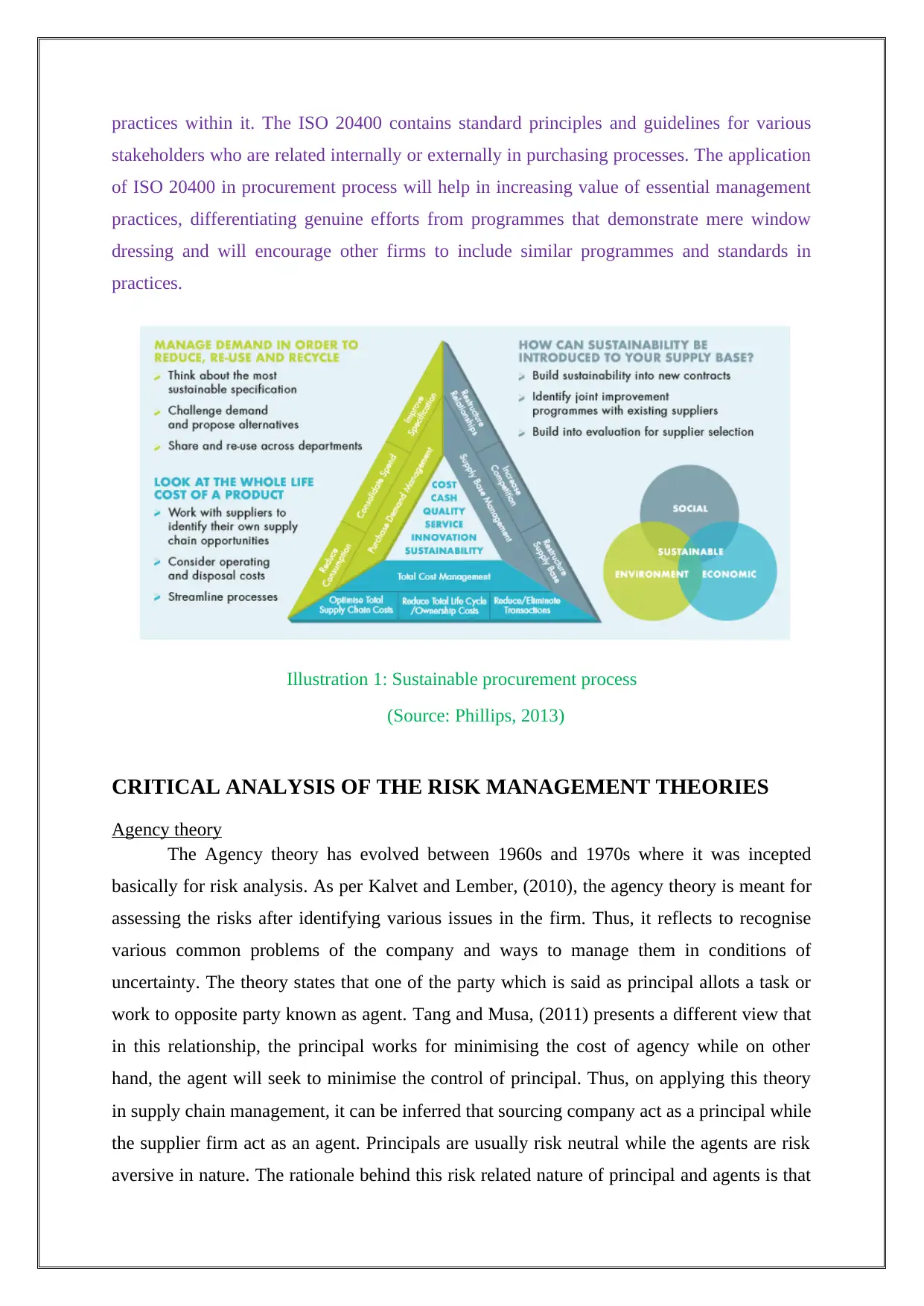
practices within it. The ISO 20400 contains standard principles and guidelines for various
stakeholders who are related internally or externally in purchasing processes. The application
of ISO 20400 in procurement process will help in increasing value of essential management
practices, differentiating genuine efforts from programmes that demonstrate mere window
dressing and will encourage other firms to include similar programmes and standards in
practices.
Illustration 1: Sustainable procurement process
(Source: Phillips, 2013)
CRITICAL ANALYSIS OF THE RISK MANAGEMENT THEORIES
Agency theory
The Agency theory has evolved between 1960s and 1970s where it was incepted
basically for risk analysis. As per Kalvet and Lember, (2010), the agency theory is meant for
assessing the risks after identifying various issues in the firm. Thus, it reflects to recognise
various common problems of the company and ways to manage them in conditions of
uncertainty. The theory states that one of the party which is said as principal allots a task or
work to opposite party known as agent. Tang and Musa, (2011) presents a different view that
in this relationship, the principal works for minimising the cost of agency while on other
hand, the agent will seek to minimise the control of principal. Thus, on applying this theory
in supply chain management, it can be inferred that sourcing company act as a principal while
the supplier firm act as an agent. Principals are usually risk neutral while the agents are risk
aversive in nature. The rationale behind this risk related nature of principal and agents is that
stakeholders who are related internally or externally in purchasing processes. The application
of ISO 20400 in procurement process will help in increasing value of essential management
practices, differentiating genuine efforts from programmes that demonstrate mere window
dressing and will encourage other firms to include similar programmes and standards in
practices.
Illustration 1: Sustainable procurement process
(Source: Phillips, 2013)
CRITICAL ANALYSIS OF THE RISK MANAGEMENT THEORIES
Agency theory
The Agency theory has evolved between 1960s and 1970s where it was incepted
basically for risk analysis. As per Kalvet and Lember, (2010), the agency theory is meant for
assessing the risks after identifying various issues in the firm. Thus, it reflects to recognise
various common problems of the company and ways to manage them in conditions of
uncertainty. The theory states that one of the party which is said as principal allots a task or
work to opposite party known as agent. Tang and Musa, (2011) presents a different view that
in this relationship, the principal works for minimising the cost of agency while on other
hand, the agent will seek to minimise the control of principal. Thus, on applying this theory
in supply chain management, it can be inferred that sourcing company act as a principal while
the supplier firm act as an agent. Principals are usually risk neutral while the agents are risk
aversive in nature. The rationale behind this risk related nature of principal and agents is that

sourcing company has the power to contact different suppliers or agents by diversifying their
investments (Mwikali and Kavale, 2012). While agents or suppliers are, dependent on
principals.
Resource dependency theory
The Resource dependency theory sets a specific view which relates with the supply
chain management for understanding the risks related to the process. Organisations use to
manage the risks because most of the times, firms are constrained as a result of external
environment. Giannakis and Louis, (2011) states that to manage the risks related to resource
dependency, a company must have the arrangements related to inter organisational
relationships. In addition to this, the theory suggests that those firms who are engaged in
supplying bulk products must have the relations and contacts with multiple numbers of
suppliers. This facility will help in minimising the most common risk of timely delivery.
There can be a number of reasons which may delay the process of supplies between
buyer and supplier. These types of reasons may comprise weather changes, issues in
transportations and many more. Therefore, to manage such kind of risks, it is essential that
the buyer company establishes contact with multiple suppliers so that risks related to the
supply management in emergent conditions can be met (Xu, 2010). Here, it can be stated that
by acquiring various external resources, required by a firm can be attained by reducing its
dependency on others and increasing others’ dependency on it.
Resource-based view theory
The resource based view is an approach that was initially given by Penrose who took
the firm as a set of resources through which organisations can differentiate themselves from
each other. The resource based view theory suggests that firms possess a number of resources
internally (Hong and Kwon, 2012). These resources are the major competitive advantage for
the firm and its competitiveness highly depends upon which universal internal resources the
organisation possesses. As per the supply chain management, it is evident that a company
must strive for using resources of its own firm as much as possible so as to save cost and also
minimise the risks related to supplies. Besides this, the mentioned approach also states that
the members who are involved in the supply chain management have a close link among
themselves so that so as to enhance their capabilities and manage risks. In addition to this, the
resources that exist externally or beyond the boundaries of organisation are required to be
accessed through management of long term relationships with suppliers so to attain
competitive advantages.
investments (Mwikali and Kavale, 2012). While agents or suppliers are, dependent on
principals.
Resource dependency theory
The Resource dependency theory sets a specific view which relates with the supply
chain management for understanding the risks related to the process. Organisations use to
manage the risks because most of the times, firms are constrained as a result of external
environment. Giannakis and Louis, (2011) states that to manage the risks related to resource
dependency, a company must have the arrangements related to inter organisational
relationships. In addition to this, the theory suggests that those firms who are engaged in
supplying bulk products must have the relations and contacts with multiple numbers of
suppliers. This facility will help in minimising the most common risk of timely delivery.
There can be a number of reasons which may delay the process of supplies between
buyer and supplier. These types of reasons may comprise weather changes, issues in
transportations and many more. Therefore, to manage such kind of risks, it is essential that
the buyer company establishes contact with multiple suppliers so that risks related to the
supply management in emergent conditions can be met (Xu, 2010). Here, it can be stated that
by acquiring various external resources, required by a firm can be attained by reducing its
dependency on others and increasing others’ dependency on it.
Resource-based view theory
The resource based view is an approach that was initially given by Penrose who took
the firm as a set of resources through which organisations can differentiate themselves from
each other. The resource based view theory suggests that firms possess a number of resources
internally (Hong and Kwon, 2012). These resources are the major competitive advantage for
the firm and its competitiveness highly depends upon which universal internal resources the
organisation possesses. As per the supply chain management, it is evident that a company
must strive for using resources of its own firm as much as possible so as to save cost and also
minimise the risks related to supplies. Besides this, the mentioned approach also states that
the members who are involved in the supply chain management have a close link among
themselves so that so as to enhance their capabilities and manage risks. In addition to this, the
resources that exist externally or beyond the boundaries of organisation are required to be
accessed through management of long term relationships with suppliers so to attain
competitive advantages.
⊘ This is a preview!⊘
Do you want full access?
Subscribe today to unlock all pages.

Trusted by 1+ million students worldwide
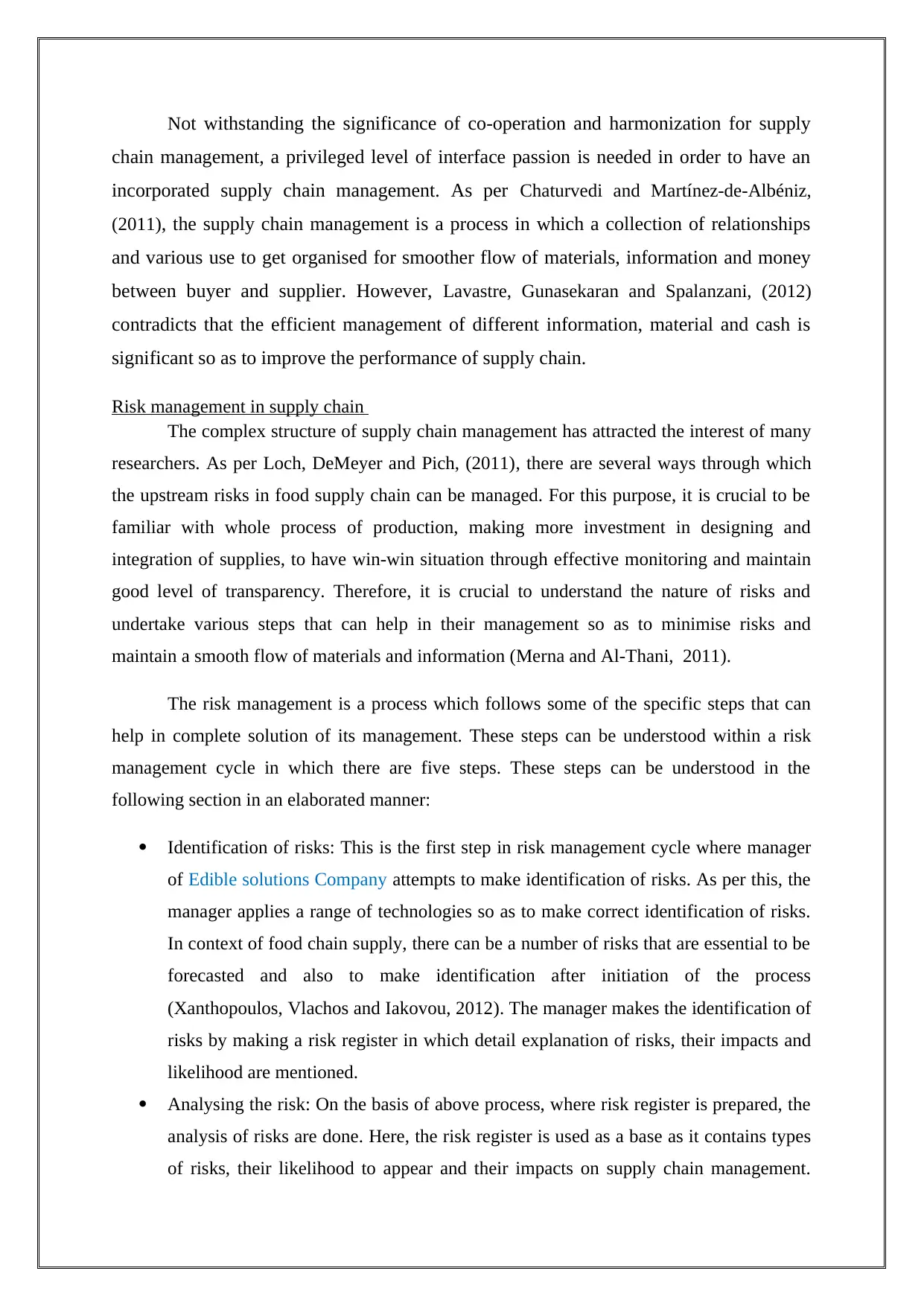
Not withstanding the significance of co-operation and harmonization for supply
chain management, a privileged level of interface passion is needed in order to have an
incorporated supply chain management. As per Chaturvedi and Martínez-de-Albéniz,
(2011), the supply chain management is a process in which a collection of relationships
and various use to get organised for smoother flow of materials, information and money
between buyer and supplier. However, Lavastre, Gunasekaran and Spalanzani, (2012)
contradicts that the efficient management of different information, material and cash is
significant so as to improve the performance of supply chain.
Risk management in supply chain
The complex structure of supply chain management has attracted the interest of many
researchers. As per Loch, DeMeyer and Pich, (2011), there are several ways through which
the upstream risks in food supply chain can be managed. For this purpose, it is crucial to be
familiar with whole process of production, making more investment in designing and
integration of supplies, to have win-win situation through effective monitoring and maintain
good level of transparency. Therefore, it is crucial to understand the nature of risks and
undertake various steps that can help in their management so as to minimise risks and
maintain a smooth flow of materials and information (Merna and Al-Thani, 2011).
The risk management is a process which follows some of the specific steps that can
help in complete solution of its management. These steps can be understood within a risk
management cycle in which there are five steps. These steps can be understood in the
following section in an elaborated manner:
Identification of risks: This is the first step in risk management cycle where manager
of Edible solutions Company attempts to make identification of risks. As per this, the
manager applies a range of technologies so as to make correct identification of risks.
In context of food chain supply, there can be a number of risks that are essential to be
forecasted and also to make identification after initiation of the process
(Xanthopoulos, Vlachos and Iakovou, 2012). The manager makes the identification of
risks by making a risk register in which detail explanation of risks, their impacts and
likelihood are mentioned.
Analysing the risk: On the basis of above process, where risk register is prepared, the
analysis of risks are done. Here, the risk register is used as a base as it contains types
of risks, their likelihood to appear and their impacts on supply chain management.
chain management, a privileged level of interface passion is needed in order to have an
incorporated supply chain management. As per Chaturvedi and Martínez-de-Albéniz,
(2011), the supply chain management is a process in which a collection of relationships
and various use to get organised for smoother flow of materials, information and money
between buyer and supplier. However, Lavastre, Gunasekaran and Spalanzani, (2012)
contradicts that the efficient management of different information, material and cash is
significant so as to improve the performance of supply chain.
Risk management in supply chain
The complex structure of supply chain management has attracted the interest of many
researchers. As per Loch, DeMeyer and Pich, (2011), there are several ways through which
the upstream risks in food supply chain can be managed. For this purpose, it is crucial to be
familiar with whole process of production, making more investment in designing and
integration of supplies, to have win-win situation through effective monitoring and maintain
good level of transparency. Therefore, it is crucial to understand the nature of risks and
undertake various steps that can help in their management so as to minimise risks and
maintain a smooth flow of materials and information (Merna and Al-Thani, 2011).
The risk management is a process which follows some of the specific steps that can
help in complete solution of its management. These steps can be understood within a risk
management cycle in which there are five steps. These steps can be understood in the
following section in an elaborated manner:
Identification of risks: This is the first step in risk management cycle where manager
of Edible solutions Company attempts to make identification of risks. As per this, the
manager applies a range of technologies so as to make correct identification of risks.
In context of food chain supply, there can be a number of risks that are essential to be
forecasted and also to make identification after initiation of the process
(Xanthopoulos, Vlachos and Iakovou, 2012). The manager makes the identification of
risks by making a risk register in which detail explanation of risks, their impacts and
likelihood are mentioned.
Analysing the risk: On the basis of above process, where risk register is prepared, the
analysis of risks are done. Here, the risk register is used as a base as it contains types
of risks, their likelihood to appear and their impacts on supply chain management.
Paraphrase This Document
Need a fresh take? Get an instant paraphrase of this document with our AI Paraphraser

These risks are analysed so as to understand their nature and various impacts that
which are potential to affect the goals of supply chain. The collected information is
analysed by the concerned manager and ways are found out for its solution (Olson and
Wu, 2010).
Evaluating and ranking risks: On the basis of risk register, the results obtained by
combining outcomes of likelihood and consequences of risks are used for ranking the
risks. Here, the cited firm makes an evaluation of risks so that a particular ranking can
be done so as to make a decision regarding whether the risk is acceptable or needs
urgent action for its treatment. On this basis of evaluation made for analysing impact
of risks, the managers in supply chain management take various decisions (Nagurney,
Masoumi and Yu, 2012).
Treat the risk: As per the above step, in which the analysis is made for giving ranking
to the risks on the basis of their seriousness are addressed for treatment. The highest
ranked risk is taken on priority basis so as to undertake steps for its solution. These
risks are treated in a way so as to minimise its impact or bringing it to the acceptable
level. This is a crucial step in which decisions related to mitigating the risks and
enhancing opportunities are taken. The contingency and preventive plans are prepared
so as to treat the highest ranked risk as per the risk register.
Monitoring and reviewing risk: This is the last step in entire process of risk
management where the manager of mentioned enterprise makes some provisions so
that he/ she can keep watch over the project risk register (Colicchia and Strozzi,
2012). This helps in monitoring entire process so that any new risk can be identified at
earlier stages and appropriate measures can be adopted for their treatment in advance.
which are potential to affect the goals of supply chain. The collected information is
analysed by the concerned manager and ways are found out for its solution (Olson and
Wu, 2010).
Evaluating and ranking risks: On the basis of risk register, the results obtained by
combining outcomes of likelihood and consequences of risks are used for ranking the
risks. Here, the cited firm makes an evaluation of risks so that a particular ranking can
be done so as to make a decision regarding whether the risk is acceptable or needs
urgent action for its treatment. On this basis of evaluation made for analysing impact
of risks, the managers in supply chain management take various decisions (Nagurney,
Masoumi and Yu, 2012).
Treat the risk: As per the above step, in which the analysis is made for giving ranking
to the risks on the basis of their seriousness are addressed for treatment. The highest
ranked risk is taken on priority basis so as to undertake steps for its solution. These
risks are treated in a way so as to minimise its impact or bringing it to the acceptable
level. This is a crucial step in which decisions related to mitigating the risks and
enhancing opportunities are taken. The contingency and preventive plans are prepared
so as to treat the highest ranked risk as per the risk register.
Monitoring and reviewing risk: This is the last step in entire process of risk
management where the manager of mentioned enterprise makes some provisions so
that he/ she can keep watch over the project risk register (Colicchia and Strozzi,
2012). This helps in monitoring entire process so that any new risk can be identified at
earlier stages and appropriate measures can be adopted for their treatment in advance.
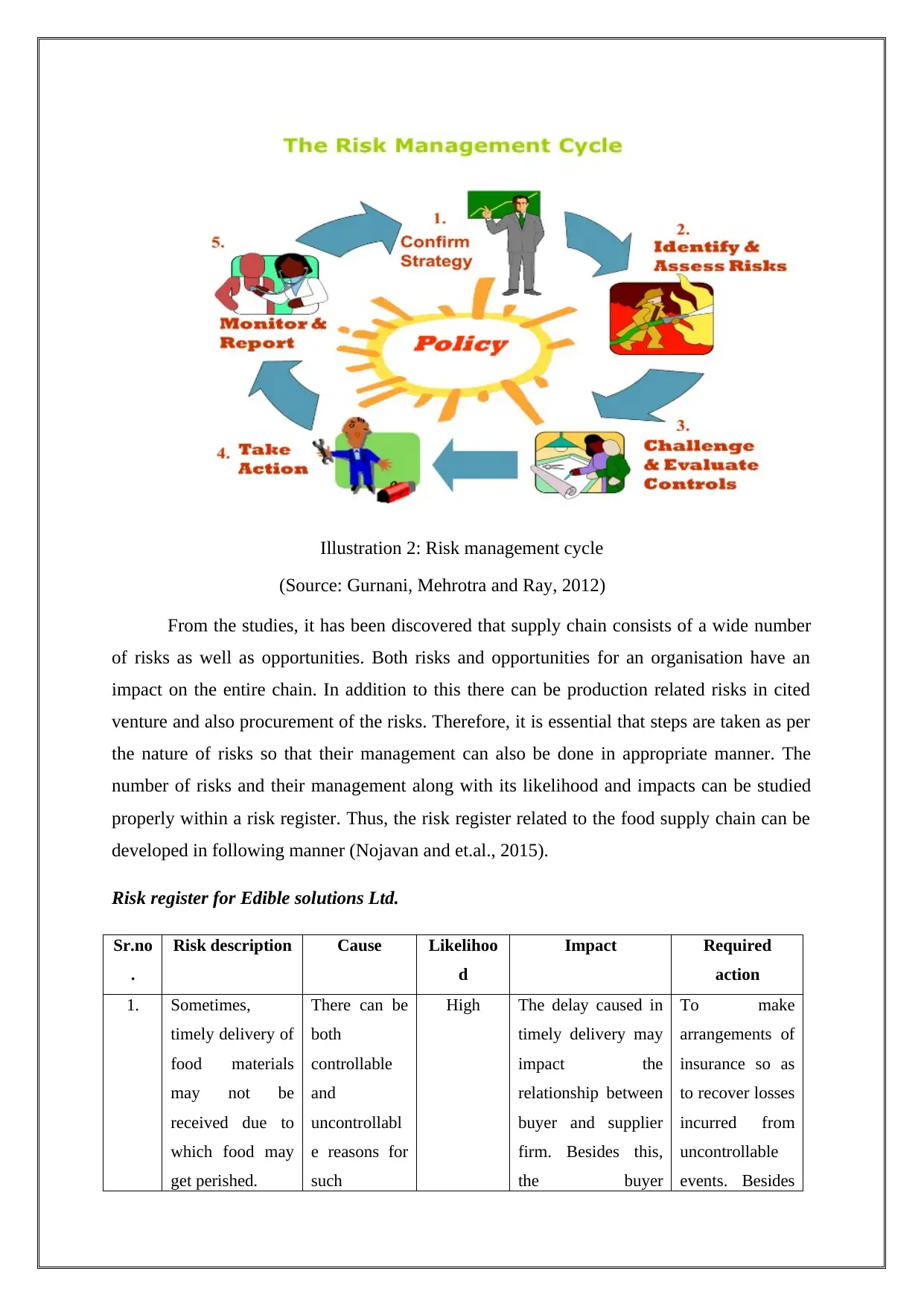
Illustration 2: Risk management cycle
(Source: Gurnani, Mehrotra and Ray, 2012)
From the studies, it has been discovered that supply chain consists of a wide number
of risks as well as opportunities. Both risks and opportunities for an organisation have an
impact on the entire chain. In addition to this there can be production related risks in cited
venture and also procurement of the risks. Therefore, it is essential that steps are taken as per
the nature of risks so that their management can also be done in appropriate manner. The
number of risks and their management along with its likelihood and impacts can be studied
properly within a risk register. Thus, the risk register related to the food supply chain can be
developed in following manner (Nojavan and et.al., 2015).
Risk register for Edible solutions Ltd.
Sr.no
.
Risk description Cause Likelihoo
d
Impact Required
action
1. Sometimes,
timely delivery of
food materials
may not be
received due to
which food may
get perished.
There can be
both
controllable
and
uncontrollabl
e reasons for
such
High The delay caused in
timely delivery may
impact the
relationship between
buyer and supplier
firm. Besides this,
the buyer
To make
arrangements of
insurance so as
to recover losses
incurred from
uncontrollable
events. Besides
(Source: Gurnani, Mehrotra and Ray, 2012)
From the studies, it has been discovered that supply chain consists of a wide number
of risks as well as opportunities. Both risks and opportunities for an organisation have an
impact on the entire chain. In addition to this there can be production related risks in cited
venture and also procurement of the risks. Therefore, it is essential that steps are taken as per
the nature of risks so that their management can also be done in appropriate manner. The
number of risks and their management along with its likelihood and impacts can be studied
properly within a risk register. Thus, the risk register related to the food supply chain can be
developed in following manner (Nojavan and et.al., 2015).
Risk register for Edible solutions Ltd.
Sr.no
.
Risk description Cause Likelihoo
d
Impact Required
action
1. Sometimes,
timely delivery of
food materials
may not be
received due to
which food may
get perished.
There can be
both
controllable
and
uncontrollabl
e reasons for
such
High The delay caused in
timely delivery may
impact the
relationship between
buyer and supplier
firm. Besides this,
the buyer
To make
arrangements of
insurance so as
to recover losses
incurred from
uncontrollable
events. Besides
⊘ This is a preview!⊘
Do you want full access?
Subscribe today to unlock all pages.

Trusted by 1+ million students worldwide
1 out of 18
Related Documents
Your All-in-One AI-Powered Toolkit for Academic Success.
+13062052269
info@desklib.com
Available 24*7 on WhatsApp / Email
![[object Object]](/_next/static/media/star-bottom.7253800d.svg)
Unlock your academic potential
Copyright © 2020–2025 A2Z Services. All Rights Reserved. Developed and managed by ZUCOL.




